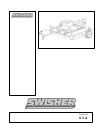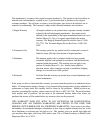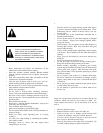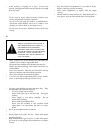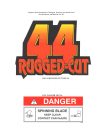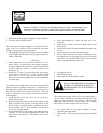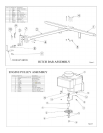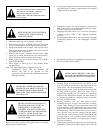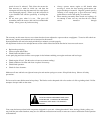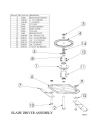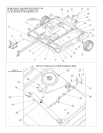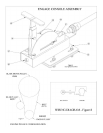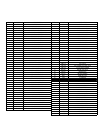
CAUTION:
FILL TO BOTTOM OF FUEL TANK FILLER
NECK.DO NOT OVERFILL WIPE OFF
SPILLED OIL OR FUEL. DO NOT
STORE, SPILL, OR USE GASOLINE NEAR
OPEN FLAME.
TO START ENGINE
CAUTION:
KEEP THE BLADE CLUTCH LEVER IN
“DISENGAGED” POSITION WHEN
STARTING ENGINE.
• Make sure spark plug wire is properly connected.
• Place throttle control in “CHOKE” position if the engine
is cold. A warm engine may not require choking to start.
• Grasp starter handle with one hand. Pull rope out slowly
until engine reaches start of compression cycle (rope will
pull slightly harder at this point).
• Pull rope with a rapid, continuous, full arm stroke. Keep
a firm grip on starter handle and let rope rewind slowly.
Do not let starter handle snap back against starter.
• When engine starts, move throttle control to the “RUN”
position (full throttle).
• Allow engine to warm up for a few minutes before
engaging blades.
Note: If at a high altitude (above 3000 feet) or in cold
Temperatures (below 32F), the carburetor fuel
mixture may need to be adjusted for best
performance (see Service and Adjustments section of
the engine manual.)
BREAKING IN YOUR CUTTER
CAUTION:
CHECK AREA UNDER AND AROUND
MOWER FOR ANY OBJECTS THAT COULD
BE THROWN FROM UNDER MOWER.
MAKE SURE THAT MOWER DISCHARGE
AREA IS CLEAR.
CAUTION:
TRAGIC ACCIDENTS CAN OCCUR IF
THE OPERATOR IS NOT ALERT TO
THE PRESENCE OF CHILDREN.
CHILDREN ARE OFTEN ATTRACTED
TO THE MACHINE AND THE MOWING
ACTIVITY. NEVER ASSUME THAT
CHILDREN WILL REMAIN WHERE YOU
LAST SAW THEM.
Break in your belts, pulleys, and engine before you actually
begin mowing for the first time.
• Start engine, engage blade control to start blades rotating
and allow blades to rotate for approximately five minutes
to break in mower and engine.
STARTING TO CUT
Caution! Never operate cutter when not seated. Serious
injury could occur.
• Starting the engine: To start the engine, be sure that the
blade control lever is in the disengaged (vertical) position.
Turn key switch to the start position.
• Engaging the blade: Move lever from the disengaged
(vertical) position down to the engaged (horizontal)
position.
• Disengaging the blade: Move the lever from the engaged
(horizontal) position up to the disengaged (vertical)
position.
Important: Make sure all bystanders are clear before
engaging blade.
Important: Know the area you are about to cut. Tall grass
can hide foreign objects and holes.
STOPPING
• Move blade clutch lever to disengaged (vertical) position.
• Turn key switch to OFF position.
SUGGESTED PRACTICES
CAUTION:
NEVER CARRY CHILDREN. THEY MAY
FALL OFF AND BE SERIOUSLY INJURED
OR INTERFERE WITH SAFE OPERATION.
• Mowing should be started with the tow vehicle in low
gear and speed increased only as mowing conditions will
safely permit. This speed should not exceed 3 ½ mph.
• Better mowing results will be obtained in those areas with
the least amount of growth. While your mower will cut
through dense growth, you will experience a substantial
increase in the horsepower required and some change in
the finished appearance as compared to those areas with
the least amount of growth.
• Mowing conditions will vary from place to place,
including the types of grass and brush that are being
mowed. When mowing tall grass and brush you may find
that the pressure of the wheel tracks may cause certain
grasses and brush to be pushed downward and will not be
mowed properly. If this condition exists you may have to
mow the area twice, the first mowing with the mower
raised and the second mowing at the normal height that
you have chosen. If it is practical, better results will be
found if the second mowing is at a right angle in travel to
the previous mowing.
• When mowing thick grass and brush you will find that the
performance of the mower will be greatly improved if the



